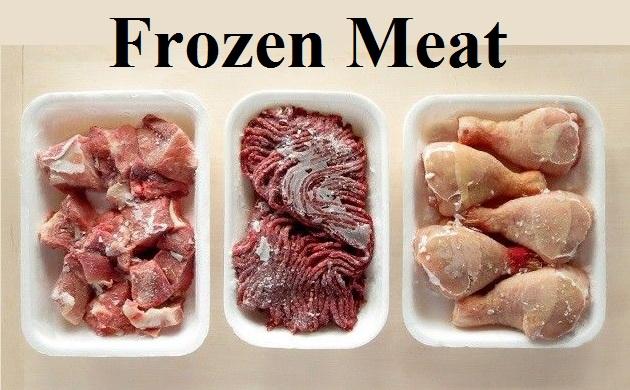Introduction
The global frozen meat industry has witnessed significant transformation over the past decade, driven by rapid advancements in cold chain logistics, rising international demand, and evolving consumer behavior. From Asia to Europe and the Middle East, frozen meat products are becoming a staple in both retail and food service sectors. For businesses involved in the frozen meat trade — particularly buffalo meat exporters — understanding these trends is critical to staying competitive and capturing new market opportunities.
In this article, we’ll explore the most important trends currently shaping the global frozen meat industry and how exporters can align their strategies to meet shifting market demands.
Top Global Trends in the Frozen Meat Industry

1. Rising Global Demand for Leaner and Healthier Meat
One of the strongest trends in the frozen meat industry is the increasing demand for leaner meat options. Consumers around the world are becoming more health-conscious, seeking out meat products that are lower in fat and cholesterol. This shift has directly benefited buffalo meat exporters, as buffalo meat is considered a healthier alternative to beef due to its lean profile, high protein content, and rich mineral composition.
Countries in the Middle East, Southeast Asia, and Africa are importing larger volumes of frozen buffalo meat to meet this rising health trend. Exporters who promote the nutritional value of their products and clearly label them accordingly are likely to stand out in this competitive space.
2. Expansion of Cold Chain Infrastructure
The backbone of the frozen meat export business is cold chain logistics. Over the past few years, there has been a substantial investment in refrigerated transportation, deep-freeze warehousing, and temperature-monitoring systems. This expansion is crucial, as it allows meat exporters to ship products over long distances without compromising on quality and food safety.
Countries like India, which is among the top buffalo meat exporters globally, have expanded their cold chain infrastructure to support the growing frozen meat trade. Advanced logistics now allow meat to be exported to markets as far as Europe, China, and Latin America while retaining its freshness and quality.
3. Increased Demand for Halal-Certified Frozen Meat
Another major trend in the industry is the increased demand for halal-certified frozen meat. In predominantly Muslim countries such as Saudi Arabia, UAE, Malaysia, and Indonesia, halal certification is not just a preference — it is a requirement. This trend has made it necessary for exporters to align their processing and slaughtering practices with halal standards in order to access and retain these lucrative markets.
Exporters offering halal buffalo meat are experiencing strong demand from these regions, especially when combined with proper packaging, labeling, and documentation. Halal certification not only builds trust with consumers but also opens the door to institutional buyers, such as hotels and restaurants, who prioritize halal suppliers.
4. Greater Focus on Sustainability and Traceability
Environmental sustainability is no longer an optional feature in the frozen meat trade — it is becoming an industry standard. Buyers are increasingly aware of the environmental impact of meat production and are looking for partners who demonstrate sustainable practices, such as ethical animal husbandry, waste reduction, and energy-efficient transportation.
Alongside sustainability, traceability is another growing requirement. Consumers and importers want to know the origin of the meat, the conditions in which the animals were raised, and how the product was processed and shipped. Exporters who implement traceability solutions using technology like blockchain, QR codes, and digital tracking can improve their reputation and transparency in the global market.
5. Digitalization of Trade and Compliance Processes
The digital transformation of the frozen meat industry is making international trade more efficient, secure, and transparent. Exporters are now using digital tools to manage everything from documentation and customs clearance to inventory and quality control.
Platforms that support e-certification, digital health certificates, and real-time shipment tracking are becoming increasingly popular. For exporters dealing with perishable goods like frozen meat, these tools can reduce delays, minimize the risk of spoilage, and ensure compliance with international regulations.
Moreover, government authorities in many importing countries are adopting digital verification processes, which means meat exporters must modernize their operations to keep pace with regulatory expectations.
6. Diversification of Export Markets
While traditional buyers such as the Gulf countries and Southeast Asia remain strongholds for frozen buffalo meat, exporters are now looking to diversify their customer base. Emerging markets in Africa, Central Asia, and Eastern Europe are showing increased appetite for affordable, frozen meat options due to population growth and rising urbanization.
This diversification reduces dependency on a single market and cushions exporters against geopolitical or regulatory disruptions. For instance, fluctuations in demand from the Middle East due to political tensions can be balanced by growing exports to Africa or Central Asia.
Exporters who invest in market research and build local partnerships in these untapped regions are better positioned for long-term growth.
7. Value-Added and Customized Products
Global buyers are no longer just looking for bulk shipments of frozen meat. There is a rising demand for value-added products, such as:
- Pre-cut meat portions
- Vacuum-packed meat
- Marinated and ready-to-cook frozen meat
Custom packaging based on retail requirements
This trend is particularly strong in the retail and foodservice sectors, where convenience and presentation play a major role. Buffalo meat exporters who diversify their offerings beyond raw cuts can attract a wider range of buyers and increase profit margins.
Offering product customization also enhances the exporter’s ability to meet the unique regulatory and cultural requirements of different regions.
8. Stricter Quality and Safety Standards
With increasing scrutiny over food safety, international markets are enforcing stricter import standards. Exporters must comply with sanitary and phytosanitary (SPS) measures, adhere to labeling laws, and follow strict temperature control protocols.
Exporters who invest in certifications such as HACCP, ISO 22000, or FSSAI compliance are more likely to build long-term trust with global importers. These standards not only ensure compliance but also signal quality assurance to both distributors and end consumers.
Conclusion
The frozen meat industry is in a phase of rapid globalization and innovation. For buffalo meat exporters and other stakeholders in the frozen meat supply chain, staying informed about emerging trends is crucial for maintaining competitiveness and growing international market share.
From leaner meat preferences and halal certifications to cold chain logistics and digital compliance tools, the future of the industry is both dynamic and promising. Exporters who are willing to adapt and invest in quality, sustainability, and market diversification will be well-positioned to lead the next wave of growth in the global frozen meat trade.












